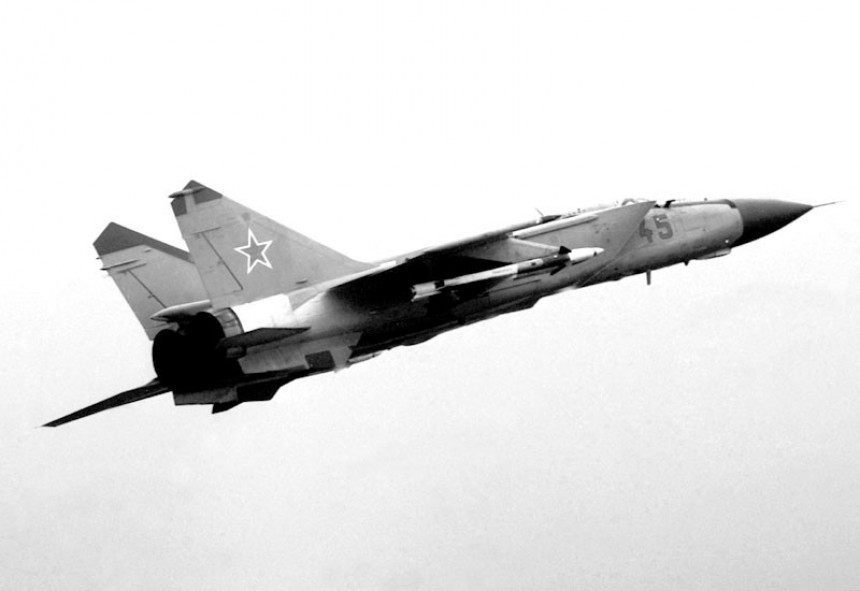The Soviet Mikoyan MiG-25 was one of the fastest aircraft ever developed. A Cold War interceptor, the Foxbat as it was called, could fly at speeds of Mach 3+ and was designed to quickly intercept American bombers. When it came out, though, the United States had no idea just how capable the aircraft really was. And the Soviet Union had frightened the USA into thinking it was a more capable aircraft than it really was. This ultimately led to the US creating the F-15 Eagle.
The MiG-25, though, remained elusive for many years. All before a disgruntled Soviet pilot defected to Japan, handing the West a priceless MiG-25 Foxbat for examination. Only then did they realize they had very little to fear regarding the Soviet interceptor.
The large wingspan hinted at great agility for the MiG-25, while the wide intakes hinted at massive engines for crazy speeds. There were even concerns that the MiG-25 was made out of lightweight titanium. Little did the US know that the MiG-25 wasn’t lightweight but very heavy. The engines, Tumansky R-15B-300s, were unreliable and thirsty and so large just because they had to lift a massive aircraft off the ground. But after this airshow appearance, only fleeting glimpses of the MiG-25 were recorded. Israeli radar controllers would track MiG-25s over the Sinai Peninsula in the early 1970s, but nothing was able to intercept the jets, flying at Mach 2.5 at least.
The United States would respond by investing more money in the development of the F-15 program. The US Navy would also go on to introduce the Grumman F-14 Tomcat into its ranks. Yet little did the United States know that they were creating an aircraft to counter one that posed very little threat other than its outrageous speeds. It could fly at speeds of 1,900 mph, but the MiG-25 couldn't cruise at that speed. Engines would only have service lives of 150 hours.
Only when Viktor Belenko defected to Japan did the United States see the true capabilities of the MiG-25. Belenko had become disillusioned with the Soviet Union and wanted a better life in the USA. So after months of planning, he faked an engine problem during a patrol and then diverted to Japan. Landing at Hakodate airport, the MiG-25 was taken in for inspection while Belenko was granted asylum in the United States. What America found was that the MiG-25 was one of the heaviest interceptors on earth, made of stainless steel and not lightweight titanium.
Even the SR-71 Blackbird was immune to its Mach 3 performance. The Blackbird just cruising right through the Soviet Union as if it was child’s play. Belenko's MiG-25 would return to the Soviet Union in pieces and allegedly is on display at an airfield in modern Russia.
Eventually, the Soviet Union created the MiG-31 Foxhound. An evolved and more developed version of the MiG-25. Faster, more capable, and lighter, the Foxhound is still in service today. Russia operated the reconnaissance MiG-25 up until 2013 when it retired its last examples. It is remarkable how a fleeting airshow appearance led to the entire United States worrying about the MiG-25. Military chiefs firmly believed that the Soviet Union had leaped ahead of them when it came to military aviation. What they found out was that the Soviet's new, advanced fighter aircraft was nothing more than two big engines with wings. Despite that, the MiG-25 is still a Cold War icon and one of the fastest military aircraft ever developed.
How the MiG-25 perplexed the United States
The Soviet Union kept the Foxbat a secret before revealing it to the public at the 1967 October Revolution airshow. A flypast of three MiG-25s flew over the crowd at an event also broadcast in English as Propaganda against the West. This was the first time the West laid eyes on the fighter, and it stunned the United States. Here was an aircraft with large air intakes and a huge wingspan that bore incredible similarities to the F-X fighter program. It was the program that would lead to the McDonell Douglas F-15. The United States worried.The large wingspan hinted at great agility for the MiG-25, while the wide intakes hinted at massive engines for crazy speeds. There were even concerns that the MiG-25 was made out of lightweight titanium. Little did the US know that the MiG-25 wasn’t lightweight but very heavy. The engines, Tumansky R-15B-300s, were unreliable and thirsty and so large just because they had to lift a massive aircraft off the ground. But after this airshow appearance, only fleeting glimpses of the MiG-25 were recorded. Israeli radar controllers would track MiG-25s over the Sinai Peninsula in the early 1970s, but nothing was able to intercept the jets, flying at Mach 2.5 at least.
How the United States responded to the MiG-25
Only when Viktor Belenko defected to Japan did the United States see the true capabilities of the MiG-25. Belenko had become disillusioned with the Soviet Union and wanted a better life in the USA. So after months of planning, he faked an engine problem during a patrol and then diverted to Japan. Landing at Hakodate airport, the MiG-25 was taken in for inspection while Belenko was granted asylum in the United States. What America found was that the MiG-25 was one of the heaviest interceptors on earth, made of stainless steel and not lightweight titanium.
The MiG-25's true capabilities were revealed to the West
Even though the wings of the Foxbat were large, this didn't make the aircraft any more agile. The wings were so big just to provide the lift to get the huge interceptor off the ground. And it was the interceptor role that the US was relieved at, knowing that its F-15 would outclass the MiG-25 in nearly every dogfight. The lack of the ability to track aircraft at a low level with its weak radar system also hurt the MiG-25's chances in air-to-air combat. The West realized it didn't need to fear the Foxbat.Even the SR-71 Blackbird was immune to its Mach 3 performance. The Blackbird just cruising right through the Soviet Union as if it was child’s play. Belenko's MiG-25 would return to the Soviet Union in pieces and allegedly is on display at an airfield in modern Russia.












